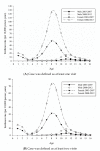The Age Distribution among Children Seeking Medical Treatment for Precocious Puberty in Taiwan
- PMID: 32957428
- PMCID: PMC7559721
- DOI: 10.3390/ijerph17186765
The Age Distribution among Children Seeking Medical Treatment for Precocious Puberty in Taiwan
Abstract
Objective: Children with precocious puberty (PP) may have increased physiological and psychological problems. In this study, we aimed to explore the trend of parents seeking medical care for their children with precocious puberty.
Methods: The Taiwan National Health Insurance Research Dataset (NHIRD) was used to estimate the prevalence (2000-2013) and incidence (2002-2013) of PP (ICD-9 code: 259.1) among boys aged 0-11 years and girls aged 0-10 years. The proportions of PP management within 1 year from the date of first diagnosis were also compared between two periods (2002-2007 and 2008-2012). The trends of PP prevalence or incidence were determined by join-point regression.
Results: In 2000, 309 boys and 2706 girls had at least one visit for PP, the crude prevalence rates (per 10,000 persons) were 0.99 (95% confidence interval, 95% CI 0.87-1.14) and 13.56 (95% CI 13.01-14.13) in boys and girls, respectively. In 2013, the crude prevalence rates increased to 7.01 (95% CI 6.56-7.84) and 110.95 (95% CI 108.97-112.96) in boys and girls, respectively. A total of 2584 girls and 207 boys with incident PP cases were identified in 2002, and 7498 girls and 739 boys were identified in 2013. For girls, the incidence rates (per 10,000 person-years) were 16.17 (95% CI 15.55-16.80) and 70.23 (95% CI 68.65-71.83) in 2002 and 2013, respectively. For boys, the incidence rates were 1.09 (95% CI 0.95-1.24) and 5.72 (95% CI 5.32-6.15) in 2002 and 2013, respectively. The sex ratio (F:M) of the incidence of PP cases was 14.89 in 2002 and 12.28 in 2013.
Conclusion: In this study, from 2000 to 2013, the frequency of visiting pediatric endocrinology outpatient clinics for precocious puberty increased in both genders. We advocate that it is important to pay increased attention to children's health, environmental hormones, and diet. Researchers should consider how to survey precocious puberty and offer parents more education to avoid the waste of medical resources or delays in seeking medical care.
Keywords: children; precocious puberty; prevalence and incidence; seeking medical care.
Conflict of interest statement
The authors declare no conflict of interest. The funders had no role in the design of the study; in the collection, analyses, or interpretation of data; in the writing of the manuscript, or in the decision to publish the results.
Figures



References
-
- Styne D.M., Grumbach M.M. Physiology and disorders of puberty. In: Melmed S., Polonsky K.S., Larsen P.R., Kronenberg H., Williams R.H., editors. Williams Textbook of Endocrinology. 13th ed. Elsevier; Philadelphia, PA, USA: 2016. pp. 1074–1218.
-
- Klein D.A., Emerick J.E., Sylvester J.E., Vogt K.S. Disorders of Puberty: An Approach to Diagnosis and Management. Am. Fam. Physician. 2017;96:590–599. - PubMed
-
- Holland-Hall C., Burstein G.R. Adolescent development. In: Kliegman R., Stanton B.F., St. Geme J.W., editors. Nelson Textbook of Pediatrics. 20th ed. Elsevier; Philadelphia, PA, USA: 2016. pp. 926–936.
Publication types
MeSH terms
LinkOut - more resources
Full Text Sources
Miscellaneous

